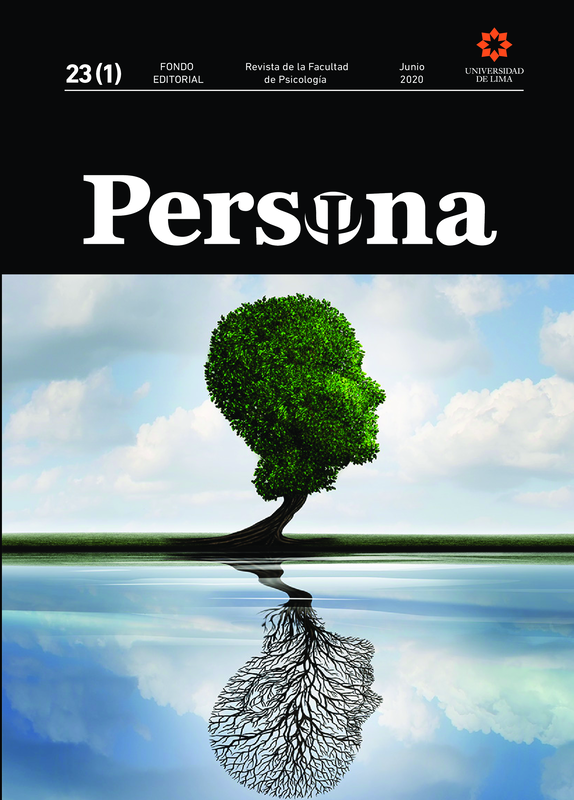Representaciones del estatus social en estudiantes de último año de educación secundaria en un colegio privado de Lima Metropolitana
Palabras clave:
Estatus social, Dominancia, Prestigio, Educación secundariaResumen
DOI: 10.26439/persona2020.n023(1).4835
El estatus social tiene un rol central en la vida del adolescente en la escuela. El presente estudio cualitativo busca analizar las representaciones del estatus social escolar en 10 estudiantes (M = 15,89, DE = 0,33) de último año de educación secundaria de un colegio privado de Lima Metropolitana. Se aplicaron grupos focales y entrevistas a profundidad. Los resultados evidencian que la dominancia y el prestigio son estrategias efectivas para ganar estatus en la escuela. Los estudiantes dominantes muestran conductas agresivas, fortaleza física y están asociados con el consumo de drogas entre sus pares; los estudiantes prestigiosos se caracterizan por el éxito académico, la conducta prosocial y logros deportivos. Se halló también que la identidad no heterosexual y ser diagnosticado con un trastorno mental afectan negativamente el estatus social en la escuela. Se discuten las relaciones entre estos factores y sus posibles implicancias.
Descargas
Referencias
Berg, B. (2008). Qualitative research in social sciences. En L. M. Given (Ed.), The SAGE encyclopedia of qualitative research methods (1.ª ed, pp. 826-831). Thousand Oaks, CA: SAGE Publications.
Berthier, N. (2006). Les techniques d’enquête en sciences sociales. Méthode et exercices. París: Armand Colin.
Bianchi, A., Lancianese, D., y Hunter, V. (2006). Gifts and social status: on-going experimental tests of behavior-status and social exchange theories. Conference Papers. American Sociological Association, 1.
Chandra, A., y Minkovitz, C. S. (2006). Factors that influence mental health stigma among 8th grade adolescents. Journal of Youth and Adolescence, 36(6), 763-774. doi: 10.1007/s10964-006-9091-0
Cheng, J. T., Tracy, J. L., Foulsham, T., Kingstone, A., y Henrich, J. (2013). Two ways to the top: evidence that dominance and prestige are distinct yet viable avenues to social rank and influence. Journal of Personality and Social Psychology, 104(1), 103-125. https://doi.org/10.1037/a0030398
Cypress, B. S. (2017). Rigor or reliability and validity in qualitative research: perspectives, strategies, reconceptualization, and recommendations. Dimensions of Critical Care Nursing, 36(4), 253-263. https://doi.org/10.1097/DCC.0000000000000253
Dilshad, R. M., y Latif, M. I. (2013). Focus group interview as a tool for qualitative research: an analysis. Pakistan Journal of Social Sciences (PJSS), 33(1), 191-198.
Eide, P. (2008). Recruiting participants. En L. M. Given (Ed.), The SAGE encyclopedia of qualitative research methods (1.ª ed., pp. 743-745). Thousand Oaks, CA: SAGE Publications.
Ennis, R. (2011). The nature of critical thinking: an out line of critical thinking dispositions and abilities. Recuperado de <a href="https://education.illinois.edu/docs/default-source/ faculty-documents/robert-ennis/thenatureofcriticalthinking_51711_000. pdf?sfvrsn=7bb51288_2 " target="_blank">https://education.illinois.edu/docs/default-source/ faculty-documents/robert-ennis/thenatureofcriticalthinking_51711_000. pdf?sfvrsn=7bb51288_2 </a>
Faris, R., y Felmlee, D. (2009). Mean girls in the middle: network centrality, gender, and bullying in adolescence. Conference Papers. American Sociological Association, 1
Faris, R., y Felmlee, D. (2011). Status struggles: network centrality and gender segregation in same and cross-gender aggression. American Sociological Review, 76(1), 48-73. https://doi.org/10.1177/0003122410396196
Fereday, J., y Muir-Cochrane, E. (2006). Demonstrating rigor using thematic analysis: a hybrid approach of inductive and deductive coding and theme development. International Journal of Qualitative Methods, 5(1), 80-92. https://doi. org/10.1177/160940690600500107
Fernández, L. (2006). ¿Cómo analizar datos cualitativos? Butlleti LaRecerca, 7(1), 1-13.
Fiske, S. T., Dupree, C. H., Nicolas, G., y Swencionis, J. K. (2016). Status, power, and intergroup relations: the personal is the societal. Current Opinion in Psychology, 11, 44-48. doi:10.1016/j.copsyc.2016.05.012
Garaigordobil, M., y Aliri, J. (2013). Relaciones del sexismo con justificación de la violencia, y con otras formas de prejuicio como la dominancia social y el autoritarismo. Estudios de Psicología, 34(2), 127-139. doi: 10.1174/021093913806751384
Gibbs, G. (2012). El análisis de datos cualitativos en investigación cualitativa. Madrid: Morata.
Henrich, J., y Gil-White, F. J. (2001). The evolution of prestige: freely conferred deference as a mechanism for enhancing the benefits of cultural transmission. Evolution and Human Behavior, 22(3), 165-196. doi:10.1016/s1090-5138(00)00071-4
Henry, S. E. (2013). Bodies at home and at school: toward a theory of embodied social class status. Educational Theory, 63(1), 1-16. doi: 10.1111/edth.12006
Hernández, R., Fernández, C., y Baptista, P. (2014). Metodología de la investigación (6.a ed.). México D. F.: McGraw-Hill.
Kahneman, D. (2013). Thinking, fast and slow. Nueva York, NY: Farrar, Straus and Giroux.
Kakkar, H., y Sivanathan, N. (2017). When the appeal of a dominant leader is greater than a prestige leader. Proceedings of the National Academy of Sciences, 114(26), 6734- 6739. doi: 10.1073/pnas.1617711114
Kakkar, H., Sivanathan, N., y Gobel, M. (2019). Fall from grace: the role of dominance and prestige in the punishment of high-status actors. Academy of Management Journal, 63(2). doi: 10.5465/amj.2017.0729
Ke, S., Lai, J., Sun, T., Yang, M. M. H., Wang, J. C. C., y Austin, J. (2014). Healthy young minds: the effects of a 1-hour classroom workshop on mental illness stigma in high school students. Community Mental Health Journal, 51(3), 329-337. doi: 10.1007/s10597-014-9763-2
Kjaran, J. I. (2017). The institutionalization of heteronormativity in schools. En Constructing sexualities and gendered bodies in school spaces (pp. 97-146). Nueva York, NY: Palgrave Macmillan.
Kopelovich, P. (2019). Fútbol como práctica de exaltación de masculinidades: el caso de un colegio secundario de sectores medios de la provincia de Buenos Aires, Argentina. Cuadernos de la Facultad de Humanidades y Ciencias Sociales. Universidad Nacional de Jujuy, 55. Recuperado de <a href="http://sedici.unlp.edu.ar/ handle/10915/90119" target="_blank">http://sedici.unlp.edu.ar/ handle/10915/90119</a>
Kornblit, A., Verardi, M., y Beltramino, F. (2009). El uso de las metodologías cualitativas en los estudios sobre drogadicción. En A. Merlino (Coord.), Investigación cualitativa en ciencias sociales (pp. 85-108). Buenos Aires: Cengage Learning.
Mascayano, F., Lips, W., Mena, C., y Manchego, C. (2015). Estigma hacia los trastornos mentales: características e intervenciones. Salud Mental, 38(1), 53-58.
Mattan, B. D., Kubota, J. T., y Cloutier, J. (2017). How social status shapes person perception and evaluation: a social neuroscience perspective. Perspectives on Psychological Science, 12(3), 468-507. https://doi.org/10.1177/1745691616677828
Milena, Z. R., Dainora, G., y Alin, S. (2008). Qualitative research methods: a comparison between focus-group and in-depth interview. Annals of the University of Oradea, Economic Science Series, 17(4), 1279-1283.
Milin, R., Kutcher, S., Lewis, S. P., Walker, S., Wei, Y., Ferrill, N., y Armstrong, M. A. (2016). Impact of a mental health curriculum on knowledge and stigma among high school students: a randomized controlled trial. Journal of the American Academy of Child & Adolescent Psychiatry, 55(5), 383-391.e1. doi: 10.1016/j.jaac.2016.02.018
Morgan, D. (2012). Focus group and social interaction. En J. F. Gubrium, J. A. Holstein, A. B. Marvasti y K. D. McKinney (Eds.), The SAGE handbook of interview research (pp. 161-176). Thousand Oaks, CA: SAGE Publications.
Noble, H., y Smith, J. (2015). Issues of validity and reliability in qualitative research. Evidence Based Nursing, 18(2), 34-35.
Panchal, S., y Gill, T. (2019). When size does matter: dominance versus prestige based status signaling. Journal of Business Research. https://doi.org/10.1016/j. jbusres.2019.03.047
Pitt, D. (2012). Mental representation. En E. N. Zalta (Ed.), The Stanford encyclopedia of philosophy. Recuperado de <a href="https://plato.stanford.edu/cgi-bin/encyclopedia/ archinfo.cgi?entry=mental-representation" target="_blank">https://plato.stanford.edu/cgi-bin/encyclopedia/ archinfo.cgi?entry=mental-representation</a>
Rahal, D., Chiang, J. J., Bower, J. E., Irwin, M. R., Venkatraman, J., y Fuligni, A. J. (2019). Subjective social status and stress responsivity in late adolescence. Stress, 1-10. doi: 10.1080/10253890.2019.1626369
Redhead, D. J., Cheng, J. T., Driver, C., Foulsham, T., y O’Gorman, R. (2018). On the dynamics of social hierarchy: a longitudinal investigation of the rise and fall of prestige, dominance, and social rank in naturalistic task groups. Evolution and Human Behavior, 40(2). doi: 10.1016/j.evolhumbehav.2018.12.001
Roberts, A., Palermo, R., y Visser, T. A. W. (2019). Effects of dominance and prestige based social status on competition for attentional resources. Scientific Reports, 9, 2473. https://doi.org/10.1038/s41598-019-39223-0
Rojas, E. (2019). Heteronormatividad escolar en México: reflexiones acerca de la vigilancia y castigo de la homosexualidad en la escuela. Sexualidad, Salud y Sociedad, 33, 180-199. https://doi.org/10.1590/1984-6487.sess.2019.33.10.a
Saunders, B., Sim, J., Kingstone, T., Baker, S., Waterfield, J., Bartlam, B., Bourroughts, H., y Jinks, C. (2018). Saturation in qualitative research: exploring its conceptualization and operationalization. Quality & Quantity, 52(4), 1893-1907. doi: 10.1007/ s11135-017-0574-8
Schensul, J. (2008). Methodology. En L. M. Given (Ed.), The SAGE encyclopedia of qualitative research methods (1.ª ed, pp. 516-521). Thousand Oaks, CA: SAGE Publications.
Searle, J. (1995). The construction of social reality. Londres: Penguin Philosophy. Sweeting, H., y Hunt, K. (2014). Adolescent socio-economic and school-based social status, health and well-being. Social Science & Medicine, 121, 39-47. doi: 10.1016/j. socscimed.2014.09.037
Toomey, R. B., McGuire, J. K., y Russell, S. T. (2012). Heteronormativity, school climates, and perceived safety for gender nonconforming peers. Journal of Adolescence, 35(1), 187-196. doi: 10.1016/j.adolescence.2011.03.001
Vieytes, R. (2009). Campos de aplicación y decisiones de diseño en la investigación cualitativa. En A. Merlino (Coord.), Investigación cualitativa en ciencias sociales (pp. 43-83). Buenos Aires: Cengage Learning.
Witkower, Z., Tracy, J. L., Cheng, J. T., y Henrich, J. (2020). Two signals of social rank: Prestige and dominance are associated with distinct nonverbal displays. Journal of Personality and Social Psychology, 118(1), 89-120. https://doi.org/10.1037/ pspi0000181
Descargas
Publicado
Número
Sección
Licencia
La aceptación de publicación implica ceder los derechos de impresión y de reproducción por cualquier forma y medio al editor, manteniendo el autor la propiedad intelectual del artículo.











